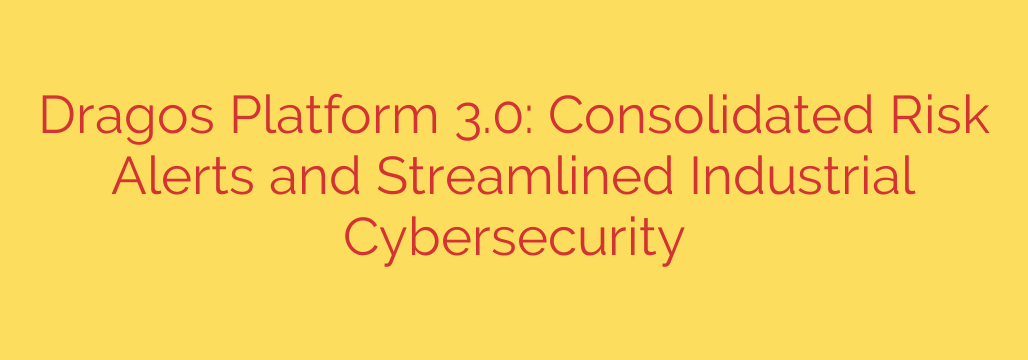
Streamlining Industrial Cybersecurity: Cut Through the Noise and Focus on Real OT Threats
In the complex world of industrial operations, cybersecurity teams face a constant challenge: protecting critical infrastructure from an ever-growing list of threats. The operational technology (OT) environment is a unique landscape of legacy systems, specialized protocols, and high-stakes physical processes. Managing its security effectively requires more than just traditional IT tools; it demands a focused, intelligent approach that understands the industrial context.
One of the most significant hurdles for security analysts is the sheer volume of alerts. Information floods in from multiple sources—vulnerability scanners, threat intelligence feeds, and asset discovery tools. Each piece of data is a signal, but when they arrive separately, they create a noisy, disjointed picture that can lead to alert fatigue and missed threats. The critical question isn’t just “What’s happening?” but “What matters most right now?”
The Power of Consolidated Risk Management
To effectively protect industrial control systems (ICS), security teams need to move beyond simply collecting data and toward a model of consolidated risk. The future of OT security lies in platforms that can intelligently synthesize information from various sources into a single, actionable insight.
Imagine a scenario: a new vulnerability is discovered on a programmable logic controller (PLC), a new threat group is known to be targeting that specific device, and unusual network traffic is detected around that same asset. In a traditional setup, this would generate three separate alerts, forcing an analyst to manually connect the dots.
A modern, streamlined approach changes the game entirely. Instead of three distinct alerts, the system generates one high-priority notification that consolidates all relevant context. This single, enriched alert instantly tells the security team:
- What: An asset has a critical vulnerability.
- Why it Matters: A known adversary is actively exploiting it.
- What’s Happening Now: Suspicious activity is currently associated with the device.
This consolidation is crucial because it transforms raw data into genuine intelligence, allowing teams to immediately grasp the severity of a situation and prioritize their response without wasting time on manual correlation.
Enhancing Visibility: You Can’t Protect What You Can’t See
Effective industrial cybersecurity begins with a foundational understanding of the environment. Without a comprehensive and accurate asset inventory, it’s impossible to manage vulnerabilities or detect threats effectively. However, simply listing assets isn’t enough. True visibility requires deep context for each device.
A robust OT security platform must provide a complete, multi-faceted view of every asset, including its location, function, communication patterns, and known vulnerabilities. This detailed inventory serves as the backbone for all security operations. When security teams have this level of insight, they can move from a reactive to a proactive posture, identifying potential weaknesses and hardening defenses before an incident occurs.
From Detection to Remediation: A More Efficient Workflow
Identifying a threat is only the first step. The ultimate goal is rapid and effective remediation. Streamlining the entire security workflow—from initial detection to final resolution—is essential for minimizing risk and operational downtime.
By integrating asset data, vulnerability information, and threat intelligence, security platforms can provide analysts with guided investigation workflows. When a critical alert is triggered, the system can automatically present all the necessary context, suggest investigative steps, and provide OT-specific response playbooks. This significantly reduces the mean time to respond (MTTR), empowering analysts to neutralize threats faster and more efficiently.
Actionable Steps to Bolster Your Industrial Cybersecurity Posture
Protecting your OT environment is an ongoing process. Here are several key steps you can take to enhance your organization’s security and resilience:
- Prioritize Comprehensive Asset Inventory: Begin by mapping out everything in your OT network. Use tools designed for industrial environments that can safely identify and classify assets without disrupting operations.
- Consolidate Your Security Signals: Evaluate your current security stack. If your teams are struggling with alert overload, look for a platform that can centralize and correlate data from different sources into a single, prioritized view of risk.
- Develop OT-Specific Incident Response Plans: Your IT incident response plan may not be suitable for an OT environment where operational uptime is paramount. Develop and practice response playbooks that are tailored to the unique constraints of your industrial processes.
- Bridge the IT/OT Knowledge Gap: Foster collaboration between your information technology and operational technology teams. Cross-training and shared goals are essential for creating a unified security culture that protects the entire organization.
Ultimately, the goal of modern industrial cybersecurity is to bring clarity and focus to a complex domain. By adopting a unified approach that consolidates risk alerts and streamlines workflows, organizations can empower their security teams to cut through the noise and concentrate on protecting the critical systems that matter most.
Source: https://www.helpnetsecurity.com/2025/09/23/dragos-platform-3-0/








